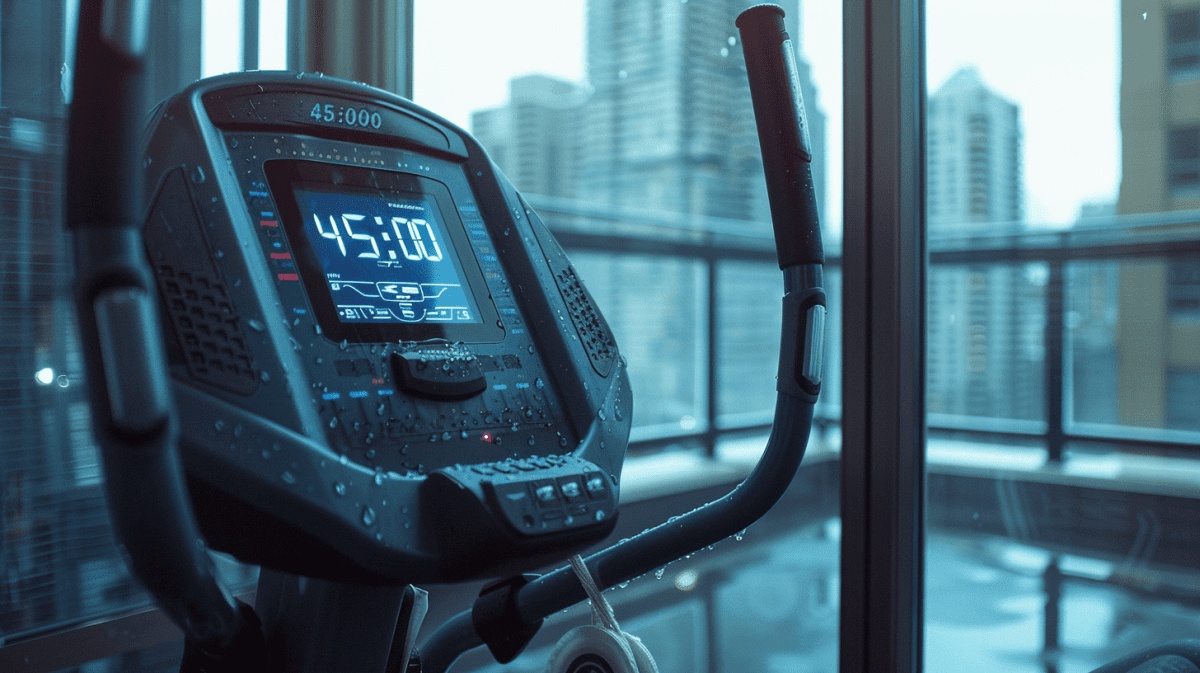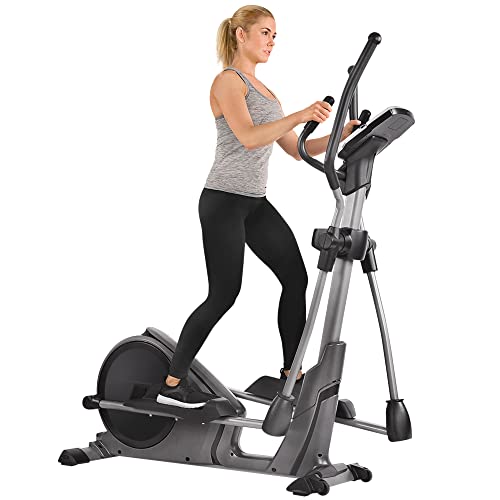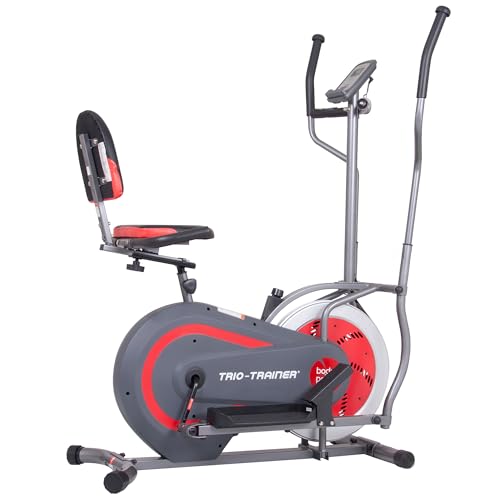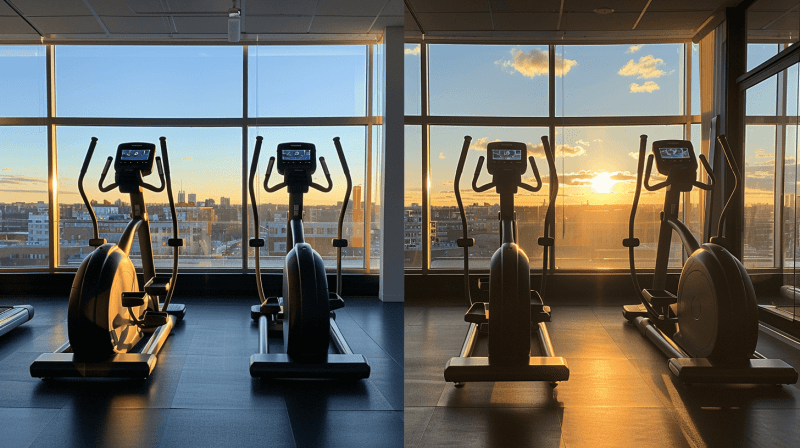While most people focus solely on the number of calories burned during exercise, your body continues to burn calories for up to 48 hours after an elliptical workout through a process called "afterburn." You'll want to capitalize on this metabolic boost by structuring your weekly elliptical sessions strategically. For ideal weight loss results, you're not just looking at how often to hop on the machine—you're crafting a sustainable routine that considers recovery time, intensity levels, and your personal schedule. Understanding these factors will help you create the most efficient workout plan for your weight loss journey.
Key Takeaways
-
Aim for 5 elliptical workouts per week, with each session lasting 30-60 minutes at moderate intensity for optimal weight loss results.
-
Maintain consistent movement for at least 30 minutes per session while being able to hold a conversation during exercise.
-
Include 2-3 HIIT sessions weekly to boost calorie burn and maximize fat loss in shorter workout durations.
-
Track your progress and gradually increase resistance and incline levels as your fitness improves.
-
Combine elliptical training with proper nutrition to achieve a realistic weight loss goal of 1-2 pounds per week.
Recommended Weekly Elliptical Training Schedule
For ideal results, structure your weekly schedule like this:
- Complete 5 workout sessions per week
- Maintain 30-60 minutes per session
- Keep your intensity at a moderate level where you can still hold a conversation
If you're short on time, you can opt for high-intensity interval training (HIIT) sessions on the elliptical. These 15-20 minute workouts can burn calories more efficiently by alternating between intense bursts of exercise and brief recovery periods.
Steady-state cardio on the elliptical burns approximately 365 calories per hour for most people. As your fitness improves, gradually increase your workout duration and intensity to continue seeing weight loss results.
Remember to listen to your body and adjust your schedule accordingly. While some people might handle five hour-long sessions per week, others might need to start with shorter durations and work their way up.
Using a fitness tracker or the elliptical's built-in monitor can help you track your progress and stay motivated throughout your weight loss journey.
Optimal Duration Per Training Session
Three key factors determine your ideal elliptical workout duration: your fitness level, weight loss goals, and available time. While there's no one-size-fits-all approach, research supports spending between 30-60 minutes on the elliptical per session for supreme weight loss results.
For steady-state cardio at moderate intensity, you'll want to aim for at least 30 minutes to effectively burn calories and kickstart your metabolism. If you're able to maintain one hour of consistent movement, you'll naturally increase the calories you burn and enhance your weight loss potential. Low-impact exercise makes the elliptical an excellent choice for those with joint concerns who still want to achieve their weight loss goals.
High-intensity interval training (HIIT) offers a more time-efficient alternative. You can burn the same number of calories in 30 minutes of HIIT as you'd in 45-60 minutes of steady-state cardio. During HIIT sessions, alternate between 30 seconds of intense effort and 90 seconds of recovery.
As you progress, gradually increase both duration and intensity of your workouts. Start with 30-minute sessions if you're new to exercise, then work your way up to longer durations as your fitness improves. Remember to maintain proper form throughout your session to maximize calorie burn and prevent injury.
The forward-backward motion of quality elliptical machines is optimal for engaging muscle groups while reducing stress on your joints during weight loss workouts.
Setting Realistic Weight Loss Goals
While mastering the right duration for your elliptical workouts matters, understanding how to set realistic weight loss goals will determine your long-term success. The elliptical machine is one of the most effective cardiovascular exercise machines to help you lose weight, but you'll need clear targets to maximize results.
According to Harvard Health, you should aim to create a caloric deficit while using the elliptical machine at least five times per week. Set a realistic goal of losing 1-2 pounds per week through a combination of diet and exercise. Your overall weight loss journey should focus on sustainable changes rather than quick fixes.
Before starting your elliptical program, consult with a healthcare provider to determine your ideal target weight based on factors like height, age, and current health status. To stay motivated, break your main goal into smaller, achievable milestones. For instance, if you need to lose 30 pounds, set monthly targets of 4-8 pounds. Track your progress regularly, but remember that factors like muscle gain and water retention can affect the number on the scale. The elliptical provides low-impact exercise that's particularly beneficial if you have joint pain or mobility concerns.
Regular elliptical workouts can help lower bad cholesterol while supporting your weight loss efforts through consistent cardiovascular exercise.
Maximizing Your Elliptical Workouts
To maximize your elliptical workouts, you'll need to implement strategic training techniques that boost calorie burn and enhance overall results. By incorporating interval training into your routine, you can drastically increase your calorie burn while improving your cardiovascular health. Alternate between high-intensity bursts and recovery periods to keep your heart rate elevated and metabolism firing.
Adjusting resistance and incline levels plays an essential role in burning more calories during your aerobic exercise sessions. Start with a comfortable baseline and progressively increase these variables as your fitness levels improve. You'll engage different muscle groups and prevent workout plateaus while optimizing health benefits.
Monitor your progress using the elliptical's built-in tracking system or connect to the SOLE+ app for detailed metrics. Keep track of your calories per session, distance covered, and heart rate to ensure you're meeting your targets. As your endurance builds, gradually increase your workout duration and intensity to continue challenging your body.
Remember to adjust your routine based on your improving fitness level, aiming for a balance between challenging yourself and maintaining proper form throughout each session. Using the arm handles correctly helps target major muscle groups in both your upper and lower body for a more comprehensive workout.
Track Progress and Adjust Intensity
Regular progress tracking forms the cornerstone of successful weight loss on the elliptical. Using your fitness equipment's built-in monitoring system or a separate tracker helps you maintain a consistent caloric deficit by ensuring you burn calories more effectively than you consume. Track essential metrics like distance covered, time spent, and heart rate to gauge your progress toward your weight loss goals.
To maximize your results, you'll need to progressively increase your workout intensity. Start by adjusting the resistance and incline settings on your elliptical, making your body work harder while maintaining the lower impact nature of the exercise. When you notice your current settings becoming easier, it's time to challenge yourself further.
Incorporate HIIT sessions into your routine to accelerate body fat reduction and improve heart health. Alternate between periods of high intensity (30-60 seconds) and recovery periods (1-2 minutes). Monitor how your body responds to these changes and adjust accordingly. If you're consistently meeting your targets without difficulty, increase duration or resistance. Conversely, if you're struggling, modify the workout to match your current fitness level while maintaining steady progress.
Building Long-Term Exercise Habits
Successful weight loss extends far beyond tracking numbers and adjusting intensity - it's about creating lasting exercise habits that stick. Using the elliptical as part of an overall fitness routine requires you to build a sustainable habit that fits naturally into your schedule. Start by committing to 3-5 days a week of exercise, allowing for proper recovery periods between sessions.
To establish consistency, choose specific days every week for your elliptical workouts and treat them like important appointments you can't miss. As you gradually increase your workout duration and intensity, you'll find it easier to maintain this routine. Remember that sustainable habits don't develop overnight - it typically takes several weeks of regular practice before an activity becomes automatic.
Combine your elliptical sessions with a healthy diet and realistic expectations. Don't try to work out every day initially; instead, focus on being consistent with your chosen schedule. If you miss a session, simply resume your routine the next scheduled day rather than trying to make up for lost time. This balanced approach helps you maintain momentum while avoiding burnout, leading to long-term success in your weight loss journey.
Frequently Asked Questions
Is 30 Minutes a Day on Elliptical Enough?
Thirty minutes can be effective if you're maximizing workout duration with high exercise intensity and proper resistance levels. For ideal weight loss goals, consider extending sessions and incorporating interval training while monitoring your heart rate.
Is Elliptical Good for Losing Belly Fat?
Like a sculptor chiseling away, your elliptical workouts can effectively target belly fat. By combining high-intensity intervals, proper resistance settings, and consistent 30-minute sessions with a healthy diet, you'll see significant results.
How Long on Elliptical for 10,000 Steps to Lose Weight?
You'll need 30-60 minutes on the elliptical to reach 10,000 steps, depending on your intensity and stride settings. Maximize calorie burn by incorporating intervals and maintaining target heart rate zones during your workout.
How Long on Elliptical to See Results?
With studies showing 150+ minutes of weekly elliptical training can burn 2000+ calories, you'll see initial results in 4-6 weeks if you maintain 30-60 minute sessions 4-5 times weekly at moderate intensity.
Conclusion
You'll achieve ideal weight loss results by sticking to 5 weekly elliptical sessions of 30-60 minutes each. Consider Sarah, who lost 30 pounds in 4 months by following this schedule and gradually increasing her resistance levels. Remember to track your progress, adjust intensity as needed, and stay consistent with your routine. When combined with proper nutrition, your elliptical training plan can help you reach your weight loss goals safely and effectively.







